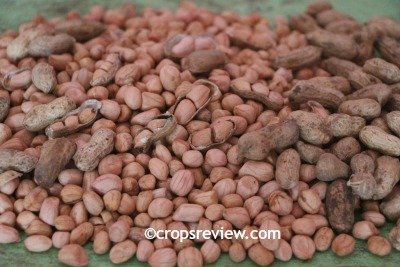Grain legumes, also called pulses, are plants belonging to the family Leguminosae (alternatively Fabaceae) which are grown primarily for their edible seeds.
These seeds are harvested mature and marketed dry to be used as food or feed or processed into various products.
Being legumes, these plants have the advantage of fixing atmospheric nitrogen for their own needs and for soil enrichment, thereby reducing the cost of fertilizer inputs in crop farming.
Crops that are harvested green for forage and for vegetables are excluded, as well as those grown for grazing or green manure.
Also excluded are the leguminous crops with seeds that are used exclusively for sowing, such as alfalfa and clover (FAO, 2010).
As defined further by the Food and Agriculture Organization (2010) of the United Nations, pulses exclude those that are used mainly for the extraction of oil, e.g., soybeans.
The definition, however, is presumed based on the main uses of the crop in consideration of world statistics.
It does not necessarily declassify the soybean and other leguminous crops as pulse crops in certain countries.
In its report entitled “Dimensions of need- Staple crops: What do people eat?,” FAO (1995) in fact listed soybean as a staple crop in China and lentil in the North-Eastern region.

Grain legumes or pulses are excellent sources of protein and B vitamins in addition to carbohydrates.
Although the protein quality is not as good as in meat generally due to low levels of the essential amino acid methionine, this can be corrected by incorporating grain legumes with cereals in the diet (Oregon State University, n.d.).
They are rich in lysine.
Especially soybeans and peanuts are good sources of vegetable oils that are used in the production of various products such as cooking oil, margarine, mayonnaise, and salad dressings (Hymowitz, 1990).
Grain Legumes: Common Names and Scientific Names
1. Adzuki bean, azuki bean, Adanka bean (Vigna angularis, syn. Phaseolus angularis)
2. Broad bean, faba bean, fava bean, bell bean, field bean (Vicia faba) (large-seeded broadbeans, windsorbeans – V. faba var. major) (horsebeans – V. faba var. major) (small, round-oval seeded tickbean, pigeon bean – V. faba var. minor)
3. Vetch, common vetch (Vicia sativa)
4. Common bean, common field bean, kidney bean, habichuela, snap bean (Phaseolus vulgaris)
5. Chick pea, Bengal gram, calvance pea, chestnut bean, dwarf pea, garbanza, garbanzo bean, garbanzos, gram, gram pea, yellow gram (Cicer arietinum)
6. Cowpea, asparagus bean, black eyed pea, black eyed bean, crowder pea, field pea, southern pea, frijole, paayap (Vigna unguiculata, syn. Vigna sinensis)
7. Guar bean, cluster bean (Cyamopsis tetragonoloba)
8. Hyacinth bean, bonavist, bataw, lablab (Dolichos lablab)
9. Lentil (Lens culinaris)
10. Lima bean, butter bean, patani (Phaseolus lunatus)
11. Lupin, lupine, lupine, sweet lupin (Lupinus spp.)
(white lupin – L. albus)
(blue lupin – L. angustifolius)
(yellow lupin – L. luteus)
(Andean lupin, pearl lupin – L. mutabilis)
(wild lupin – L. perennis)
12. Mung bean, mungbean, mungo (Vigna radiata, syn.: Phaseolus aureus)
13. Pea, dry pea, podded pea, snap pea, chicharo (Pisum sativum)
14. Peanut, groundnut, earth nut, mani, runner peanut (Arachis hypogaea)
15. Pigeon pea, kadios (Cajanus cajan)
16. Soybean, soya, soyabean (Glycine max)
17. Tepary bean, tepari bean (Phaseolus acutifolius)
Top Producers of Some Grain Legumes in the World as of 2013 (updated from FAOSTAT 2016):
- Beans, dry – Myanmar
- Broad beans, horse beans, dry – China, mainland
- Chick peas – India
- Cowpeas, dry – Nigeria
- Groundnuts, with shell – China, mainland
- Lentils – Canada
- Lupins – Australia
- Peas, dry – Canada
- Pigeon peas – India
- Soybeans – USA
- Vetches – Ethiopia
Addendum: Grain Legumes vs. Legumes
Grain legumes or pulses are not exactly the same as legumes.
The word “legumes” or “leguminous plants” is a collective term for all plants under the family Leguminosae or Fabaceae.
It is a large grouping of plants that consists of both useful plants (agricultural crops) and unuseful plants (weeds).
Of the agricultural crops, it includes those which are not grown for the harvesting of seeds but for some other purposes.
Few examples are for root-like yam bean or singkamas, for edible flowers like the katuray or Sesbania, for fruit (technically called pod or legume) like string beans and winged bean, and also for forage and as cover crops like the butterfly pea or Centro, and for ornamental purposes like the creeping peanut.
All grain legumes are agricultural crops that are intentionally grown for the harvesting of mature seeds.
They are just, therefore, a small fraction of leguminous agricultural crops and much smaller as members of the entire leguminous plants.
REFERENCES
- Center for New Crops and Plant Products. 2010. Purdue University. Retrieved October 23, 2010 from http://www.hort.purdue.edu/newcrop/default.html.
- Chapman, S.R. and L.P. Carter. 1976. Crop Production: Principles and Practices. San Francisco: W.H. Freeman and Company. pp. 337-357.
- FAOSTAT. 2016. http://faostat3.fao.org/browse/rankings/countries_by_commodity/E, accessed Sept. 27, 2016.
- Food and Agriculture Organization (FA0). 2010. Crops statistics – concepts, definitions and classifications. Retrieved May 29, 2010 from http://www.fao.org/economic/ess/methodology/methodology-systems/crops-statistics-concepts-definitions-and-classifications/en/.
- Food and Agriculture Organization (FAO). 1995. Dimensions of need- Staple crops: what do people eat? Retrieved October 23, 2010 from http://www.fao.org/docrep/u8480e/u8480e07.htm.
- Hymowitz, T. 1990. Grain legumes. p. 54-57. In: J. Janick and J.E. Simon (eds.), Advances in new crops. Timber Press, Portland, OR. Retrieved October 23, 2010 from http://www.hort.purdue.edu/newcrop/proceedings1990/V1-154.html.
- Myers, R. 2010. Grain legumes. Retrieved October 22, 2010 from http://www.hort.purdue.edu/newcrop/cropmap/missouri/crop/pulse.html.
- Oregon State University. n.d. Classification of crops and their role in human nutrition. OSU Extended Campus. Retrieved October 23, 2010 from http://oregonstate.edu/instruct/css/330/two/index2.htm.
- Peel, L. 2003. Harper Collins Practical Gardener: Kitchen Garden. New York, N.Y.: Harper Collins Publishers Ltd. pp. 78-83.
- Tabinga, G.A. and A.O. Gagni. 1982. Field Legumes Production in the Philippines. UPLB, College, Laguna: Department of Development Communication. 57 p
